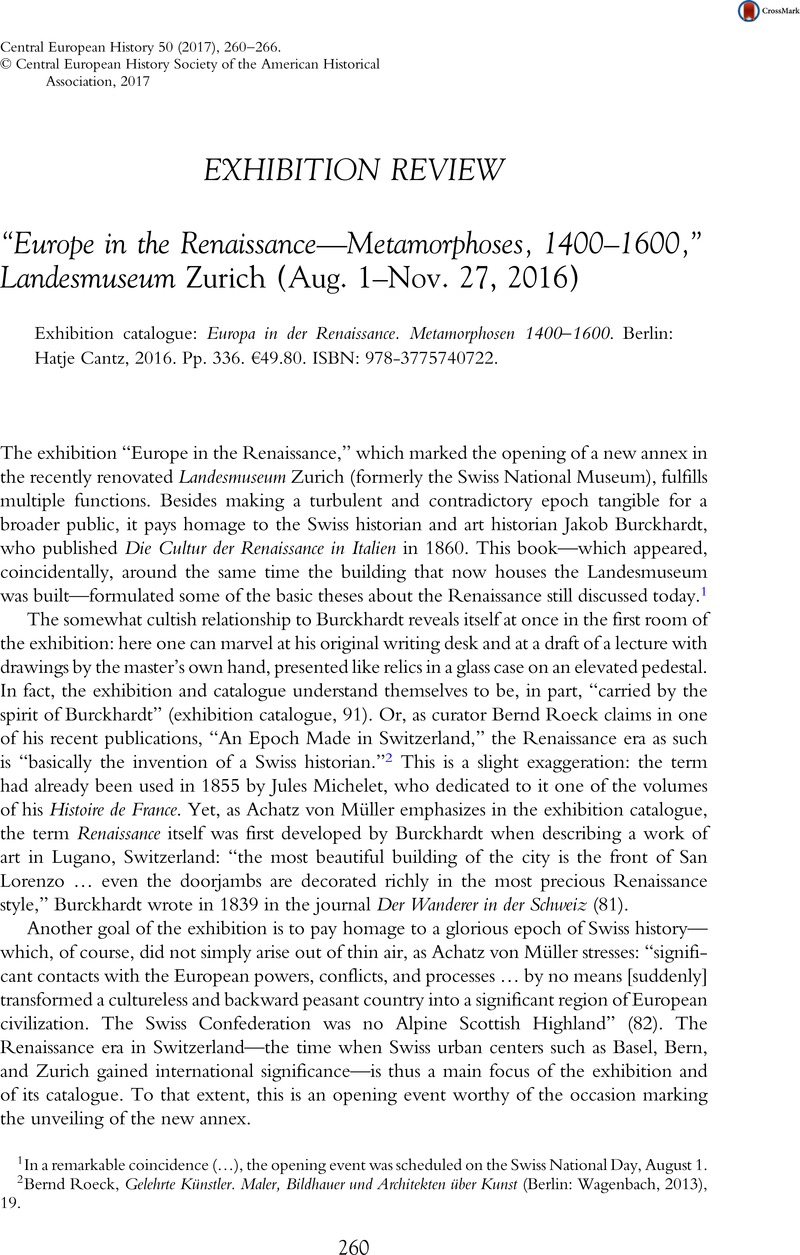No CrossRef data available.
Article contents
“Europe in the Renaissance—Metamorphoses, 1400–1600,” Landesmuseum Zurich (Aug. 1–Nov. 27, 2016) - Exhibition catalogue: Europa in der Renaissance. Metamorphosen 1400–1600. Berlin: Hatje Cantz, 2016. Pp. 336. €49.80. ISBN: 978-3775740722.
Review products
Published online by Cambridge University Press: 29 June 2017
Abstract

- Type
- Exhibition Review
- Information
- Copyright
- Copyright © Central European History Society of the American Historical Association 2017
References
1 In a remarkable coincidence (…), the opening event was scheduled on the Swiss National Day, August 1.
2 Roeck, Bernd, Gelehrte Künstler. Maler, Bildhauer und Architekten über Kunst (Berlin: Wagenbach, 2013), 19Google Scholar.
3 See, e.g., Bailey, Gauvin A., The Jesuits and the Grand Mogul: Renaissance Art at the Imperial Court of India, 1580–1630 (Washington, DC: Smithonian Institution, 1998)Google Scholar; Brotton, Jerry, The Renaissance Bazaar, From the Silk Road to Michelangelo (Oxford: Oxford University Press, 2002), 33–61 Google Scholar.
4 See, e.g., Al-Khalili, Jim, Pathfinders: The Golden Age of Arabic Science (London: Allen Lane, 2010)Google Scholar; Frankopan, Peter, The Silk Roads (London: Bloomsbury, 2015)Google Scholar.
5 Roeck, Gelehrte Künstler, 17–29 (quote on p. 17).
6 Ibid., 24.
7 For artistic relations between Italy and the Ottoman Empire, see Necipoglu, Gulru, “Suleyman the Magnificent and the Representation of Power in the Context of Ottoman-Habsburg Papal Rivalry,” The Art Bulletin 71 (1989): 401–27Google Scholar; for recent research on the Eastern art regions of Europe, see, e.g., Lipinska, Aleksandra, “Eastern Outpost: The Sculptors Herman Van Hutte and Hendrik Horst in Lviv c. 1560–1610,” in Nederlands Kunsthistorisch Jaaboeck 63 (2014): 136–79Google Scholar; “Migration of Artists in Central and Eastern Europe 1500–1900,” Kunsttexte.de/ostblick 2 (2014)Google Scholar, http://www.kunsttexte.de/?id=661.
8 See, e.g., Belting, Hans, Florenz und Bagdad: Eine westöstliche Geschichte des Blicks (Munich: C.H. Beck Verlag, 2008)Google Scholar.
9 See, e.g., Compier, Abdul-Haq, “Rhazes in the Renaissance of Andreas Vesalius,” Medical History 56, no. 1 (2012): 3–25 CrossRefGoogle ScholarPubMed.




